|
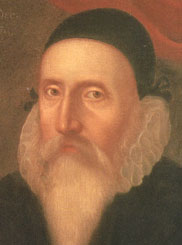 John Dee (1547-1608)
John Dee (1547-1608)
[Ashmolean Museum]
|
One of the arguments used by anti-masons to support their claim that Freemasonry is satanic is to refer to the masonic use of the pentagram. The short answer to this accusation is that the pentagram has no masonic significance beyond its association with Pythagoras and the Golden Ratio, and is not mentioned in any published masonic ritual.
|
|
|
|
The pentagram:
additional illustrations
(Appendix 1)
|
 |
 |
 |
 Mediaeval and Renaissance authors of hermetic manuscripts and texts made use of a large number of figures, sigils, seals and designs based on the iconography of alchemy, astrology and magic squares. The pentagram does not appear to have been a central theme or image, being restricted mainly to a warding device. Mediaeval and Renaissance authors of hermetic manuscripts and texts made use of a large number of figures, sigils, seals and designs based on the iconography of alchemy, astrology and magic squares. The pentagram does not appear to have been a central theme or image, being restricted mainly to a warding device.
 There are no pentagrams found in The Book of the Sacred Magic of Abramelin the Mage(1655), Robert Turner’s 1657 edition of The Ars Notoria - The Notary Art of Solomon; The Fourth Book of Occult Philosophy(1654), (Robert Turner’s collection: Of Geomancy and Of Occult Philosophy, attributed to Agrippa; Isagoge by Georg Pictorius Villinganus; On Astronomical Geomancy by Gerard Cremonensis; and The Arbatel of Magic; The Hieroglyphic Monad(1564) by Dr. John Dee, The Rosicrucian Manifestos: Fama Fraternitatis(1615) and Confessio Fraternitatis(1616); nor The Chymical Wedding of Christian Rosenkreutz. There are no pentagrams found in The Book of the Sacred Magic of Abramelin the Mage(1655), Robert Turner’s 1657 edition of The Ars Notoria - The Notary Art of Solomon; The Fourth Book of Occult Philosophy(1654), (Robert Turner’s collection: Of Geomancy and Of Occult Philosophy, attributed to Agrippa; Isagoge by Georg Pictorius Villinganus; On Astronomical Geomancy by Gerard Cremonensis; and The Arbatel of Magic; The Hieroglyphic Monad(1564) by Dr. John Dee, The Rosicrucian Manifestos: Fama Fraternitatis(1615) and Confessio Fraternitatis(1616); nor The Chymical Wedding of Christian Rosenkreutz.
 Giovanni Battista Nazari’s Il metamorfosi metallico et humano... Brescia, 1564, retitled Della tramutatione metallica sogni tre... in 1572 and 1599, does not depict the pentagram. The illustrations are reminiscent of woodcuts in the Hypnerotomachia Poliphilio, 1499, which also does not depict the pentagram. Giovanni Battista Nazari’s Il metamorfosi metallico et humano... Brescia, 1564, retitled Della tramutatione metallica sogni tre... in 1572 and 1599, does not depict the pentagram. The illustrations are reminiscent of woodcuts in the Hypnerotomachia Poliphilio, 1499, which also does not depict the pentagram.
 Roberto Fludd’s titlepage for Utrusque Cosmi MALORIS solicet MINORIS METAPHYSICA, PHYSICA ATQUE TECHNICA HISTORIA, Oppenheim: 1617, uses an illustration of a male figure inside concentric rings on the cover but, like the balance of his published works, no pentagram. John Dee included a pentagram, one point up, in a seal designed in wax, now in the British Museum, but does not include any pentagram in a similar gold disc. No other text ascribed to Dee incorporates a pentagram image. Roberto Fludd’s titlepage for Utrusque Cosmi MALORIS solicet MINORIS METAPHYSICA, PHYSICA ATQUE TECHNICA HISTORIA, Oppenheim: 1617, uses an illustration of a male figure inside concentric rings on the cover but, like the balance of his published works, no pentagram. John Dee included a pentagram, one point up, in a seal designed in wax, now in the British Museum, but does not include any pentagram in a similar gold disc. No other text ascribed to Dee incorporates a pentagram image.
 A collection of 244, predominantly mediaeval, illustrations in Ernst and Johanna Lehner’s Devils, Demons, and Witchcraft, has no depictions of pentagrams. Noteworthy is a pact with the infernal powers allegedly signed and sealed by Lucifer and Satan in 1634. A collection of 244, predominantly mediaeval, illustrations in Ernst and Johanna Lehner’s Devils, Demons, and Witchcraft, has no depictions of pentagrams. Noteworthy is a pact with the infernal powers allegedly signed and sealed by Lucifer and Satan in 1634.
 The twentieth century preoccupation with identifying the pentagram with magic appears to be the result of opinions expressed by Éliphas Lévi and Aleister Crowley. The images seen below, and at <freemasonry.bcy.ca/anti-masonry/pentagram.html>, represent the greater number of usages prior to Éliphas Lévi in 1861. The twentieth century preoccupation with identifying the pentagram with magic appears to be the result of opinions expressed by Éliphas Lévi and Aleister Crowley. The images seen below, and at <freemasonry.bcy.ca/anti-masonry/pentagram.html>, represent the greater number of usages prior to Éliphas Lévi in 1861.
 Unrelated to any overtly mystical usage, Colonel Allotte de la Fuÿe in Le Pentagramme Pythagoricien, notes five cuneiform impressions of the pentagram taken from Fara, Sargon and Gudea. Unrelated to any overtly mystical usage, Colonel Allotte de la Fuÿe in Le Pentagramme Pythagoricien, notes five cuneiform impressions of the pentagram taken from Fara, Sargon and Gudea.
|
 |
 |
 |
 |
 |  |  |
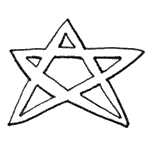
| |
1. Mesopotamian City Seal Impression: 3,500-2,700 BCE. "The term 'city seal impressions' is used to mean those impressions representing, or at least thought to be representing, names of cities." [p. 33.] Detail of Figure 12:5. U14169. IM 49703. UE 3:400. UET 2:323. SIS4. H .3.8, L .4.9. One rolling. Rather freely arranged symbols: U 4+NUN (Adab), UB, bird, SU2 AN DUG3+DU3 (kesh), URI3+AB (Ur), ?AN, ?edinnu. Filler motifs in field. Sealing 5.5 x 4.6 x 2.0. Reverse eroded, no clear marks. Functional type: ? [p. 62.]
Cities, Seals and Writing: Archaic Seal Impressions from Jemdet Nasr and Ur. Roger J. Matthews, British Archaeological Expedition to Iraq, Baghdad. Gebr. Man Verlag, Berlin: 1993. ISBN: 3-7861-1686-5 [Materialien Zu Den Frühen Schriftzeugnissen des Vorderen Orients, Band 2 (MSVO II)] 73 p. plus 29 figures and 3 plates.
|
 |
 |  |  |
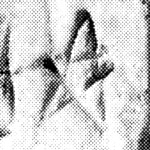
| |
2. Catalogue description [p. 60.] Tablet No. MSVO 1, 60, Ashmolean Museum, Oxford.
MSVO 1 = Englund, R.K. and Grégoire, J.-P., 1991. The proto-cuneiform texts from Jemdet Nasr. 1: copies, transliterations and glossery. (Materialien zu den frühen Schriftzeugnissen des Vorderen Orients 1). Berlin, Gebr. Mann.
"Another motif which occurs in a variety of forms is the five-pointed star or UB sign. There is a possibility that this city represents the city of Umma, later known in one of its name forms as UB=ME (Lambert 1990, 78) but there is perhaps a likelier candidate for ancient UB in the site of Jemdet Nasr, where excavations in the 1920s yielded several artifacts bearing the UB sign, such as spindle whorls (Mackay 1931, Pl. 24:9) and painted ports (Field and Martin 1935, Pl. 33:3), as well as numerous tablets with incised UB signs. More recent excavations have recovered a fragment of a baked clay cylinder seal with an UB sign (Matthews 1989a, Fig. 4:1). With the exception of an amulet with an UB sign from Tell Agrab (Delougaz 1952, 47) such non-textual representations of the UB sign are not known to me from other Mesopotamian sites, which strengthens the claim of Jemdet Nasr to be ancient UB." [p. 41-42.]
Plate 1a. Matthews, Ibid.
|
 |
 |  |  |
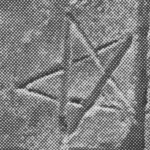
| |
3. Plate IX (79) 212. Ash. 1926-566. [bottom left]
Robert K. Englund and Jean-Pierre Grégoire. The proto-cuneiform texts from Jemdet Nasr. 1: copies, transliterations and glossery. (Materialien zu den frühen Schriftzeugnissen des Vorderen Orients 1). With a contribution by Roger J. Matthews. Berlin, Gebr. Mann Verlag: 1991. ISBN: 3-7861-1646-6.
|
 |
 |  |  |
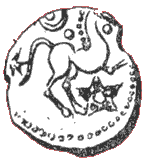
| |
4. Plate IIa. "British Coin with pentagram, 2nd cent. B.C." Cornelia J. de Vogel, Pythagoras and Early Pythagoreanism, An Interpretation of Neglected Evidence on the Philosopher Pythagoras. Assen, Netherlands: Van Gorcum, 1966. Note also: b. Gallic coins with pentagram, 1st cent. B.C.; c. Small symbols on the denarii of L. Papius, c. 78 B.C.; d. Inscription on a tombstone in Tortosa (Spain) 4th cent. A.D. [plate facing page 34]
|
 |
 |  |  |
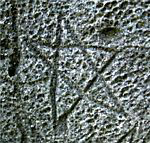
| |
5. The monastery of Ravna, Bulgaria, consecrated in 889 CE, existed from the end of the ninth to the end of the tenth century. Of the 3000 odd graffito-drawings found in the church, the scriptorium with library and school, and the refectory and dormitory, a total of 25 are pentagrams. Most of the graffiti have a shallow profile (1 mm width and length). The authors of these images and their motives is unknown.
Rossina Kostova (in: Mitteilungen der ANISA 17.Jg. 1996) EU-Budapest, Hungary, Veliko Turnovo University, Bulgaria. 1994-95 MA thesis, Department of Medieval Studies, Central European University, Budapest, Departmental Library.
|
 |
 |  |  |
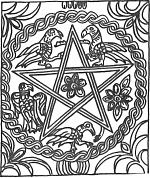
| |
6. "Pentacle on baptismal font of Sibenik Cathedral (Dalmatia). Marble relief, medieval."
Dictionary of Symbolism: cultural icons and the meanings behind them, Hans Biedermann (1930-1990). Meridian, New York: 1994. ISBN: 0-452-01118-3. p. 262.
Compare this with Eckhardt’s illustration from a carving on a wall in the Baptistory of St. John at Split, 50 km south on the Croatian coast, or the next image.
|
 |
 |  |  |

| |
7. Found at www.hr/darko/gif/ple.jpg. Whether Eckhardt and Biedermann are confusing the same carving or if they are illustrating two different carvings is unclear.
|
 |
 |  |  |
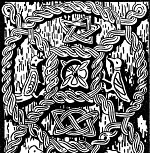
| |
7a. This illustration is taken from an intrecci remains from the ninth century found in a parapet of the Church of Saint Abbondio (Como, Lombardy, northern Italy), founded in 1013 CE. Although irregular, a pentagram knot can be seen in the top quartering. The overall effect is reminiscent of the preceding two figures. [Mackey’s Encyclopedia, Vol. 2, p. 234.]
|
 |
 |  |  |
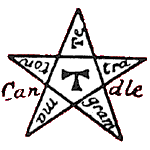
| |
8. Frontispiece detail. The Lesser Key of Solomon, Goetia, The Book of Evil Spirits, contains two hundred diagrams and seals for invocation and convocation of spirits, necromancy, withcraft [sic] and black art. Translated from ancient manuscripts in the British Museum, London. Ceremonial Magic, Only Authorized Edition Extant, Published Under the Editorship of L. W. de Laurence, Member of the Eastern Order of Sacred Mysteries, De Laurence, Chicago. Copyright, 1916 by de Laurence Scott & Co. 80p. 13cm x 19.5 cm. [translation of the first book of the Lemegeton by Macgregor Mathers in 1903.] Out of 200 drawings of seals, three contain pentagrams, all one point up: figs. 34, 156 and frontispiece, 153. Also see Greater Key of Solomon.
|
 |
 |  |  |
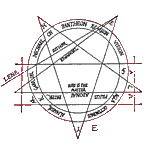
| |
9. De Nigromancia (attributed to) Roger Bacon [c. 1220-1292] Sloane MS. 3885 & Additional MS. 36674. edited and translated by: Michael-Albion Macdonald. Heptangle Books, Gilletten, New Jersey: 1988. ISBN: 0-935214-10-0 96 p. 14cm x 22cm.[of 8 figs. one is a pentagram: fig. on p. 50.]
|
 |
 |  |  |
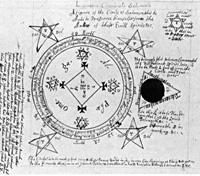
| |
10. "Plate 9. The magic circle and triangle of Solomon, with pentagram, from a late medieval magic text book, the Lemegeton. [Bibliothèque Nationale, Paris.]" A History of Magic, Richard Cavendish. Sphere Books Limited, 30/32 Gray’s Inn Road London WC1X 8JL. 1978 pb.
|
 |
 |  |  |
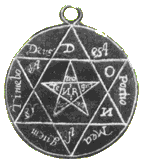
| |
11. "Plate 12. Gnostic gems and amulets, used as portable magical power sources [1 of 9: only one with pentagram or hexagram. The Danish National Museum, Copenhagen.]" A History of Magic, Richard Cavendish. Sphere Books Limited, 30/32 Gray’s Inn Road London WC1X 8JL. 1978 pb.
|
 |
 |  |  |
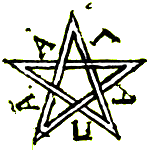
| |
12. Sir Robert Moray (1609-1673) used the pentacle as his personal mark prior to his initiation into Freemasonry in the Edinburgh Lodge on May 20, 1641. An example can be found in a letter of March 28, 1641. His interpretation and use of the pentagram were personal and did not reflect masonic usage of the period. Moray wrote to Alexander Bruce in 1658:
 "This character or Hyeroglyphick, which I call a starre, is famous amongst the Egyptians and Grecians. For the Egyptian part of it I remitt you to Kircherus [Athanasius Kircher] bookes that I named in my last. The Greekes accounted it the symbol of health and tranquility of body and mind, as being composed of capitall letters that make up the word Hygieia, and I have applied five other letters to it that are the initials of 5 words that make up the summe of Christian Religion, as well as stoick philosophy, all which are to be found in it without much distortion or constraint, and make up the sweet word Agapa, which you know signifies love thou, or hee loves, which is the reciprocall love of God and man, and that same word is one of the 5 signified by the 5 letters. The rest are Gnothi, Pisteuei, Anecho, Apecho. There’s enough at once. On the reverse if it were a double seal I would have my Crest in a wreath, being a solid starr rising with ridges from the points to the centre."
Kincardine papers, f. 67r, property of the earl of Elgin. A microfilm copy can be found in Edinburgh University Library Mic, M.714. The Greek words italicised in this transcript are in Greek characters in the original. Cf.: The Origins of Freemasonry. Scotland’s century 1590-1710. David Stevenson, Ph.D. Cambridge, Cambridge University Press 1988. pp. 169, 173. Rotated pentacle image from cover art.
"This character or Hyeroglyphick, which I call a starre, is famous amongst the Egyptians and Grecians. For the Egyptian part of it I remitt you to Kircherus [Athanasius Kircher] bookes that I named in my last. The Greekes accounted it the symbol of health and tranquility of body and mind, as being composed of capitall letters that make up the word Hygieia, and I have applied five other letters to it that are the initials of 5 words that make up the summe of Christian Religion, as well as stoick philosophy, all which are to be found in it without much distortion or constraint, and make up the sweet word Agapa, which you know signifies love thou, or hee loves, which is the reciprocall love of God and man, and that same word is one of the 5 signified by the 5 letters. The rest are Gnothi, Pisteuei, Anecho, Apecho. There’s enough at once. On the reverse if it were a double seal I would have my Crest in a wreath, being a solid starr rising with ridges from the points to the centre."
Kincardine papers, f. 67r, property of the earl of Elgin. A microfilm copy can be found in Edinburgh University Library Mic, M.714. The Greek words italicised in this transcript are in Greek characters in the original. Cf.: The Origins of Freemasonry. Scotland’s century 1590-1710. David Stevenson, Ph.D. Cambridge, Cambridge University Press 1988. pp. 169, 173. Rotated pentacle image from cover art.
|
 |  |  |

| |
13.One Mi'kmaq heiroglyphic representing heaven.
Symbole der Indianer Nordamerikas, Heike Owusu. Darmstadt : Schirner Verlag, 1997, p. 212. Note that other translations use variations on the pictograms.
That found at booth.k12.nf.ca uses a uniform, one point down, pentagram.
|
 |
 |  |  |
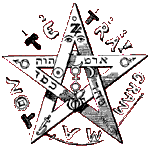
| |
14. Dogme et Rituel de la Haute Magie Part I: The Doctrine of Transcendental Magic. Eliphas Lévi (Alphonse Louis Constant). Translated by A. E. Waite.
Originally published by Rider & Company, England, 1896. Transcribed and converted to Adobe Acrobat format by Benjamin Rowe, June, 2001. [p. 25 image of pentagram]
|
 |
 |  |  |
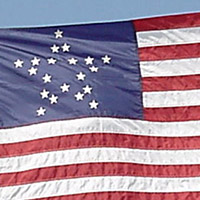
| |
15. The Great Star Flag—with twenty stars— was designed by Captain Samuel Chester Reid, U.S. Navy, at the request of New York Congressman Peter Wendover and flown over the U.S. Capitol on 13 April 1818. Variations on this flag, with additional stars as states joined the Union, were common up until the American Civil War. Several extant versions display the pentagram with one point down.
crwflags.com/fotw/flags/us-gstar.html
gba.wavethemes.net/usa-flags.html
cterwilliger.com/flags/flags2.html
|
 |
 |  |  |
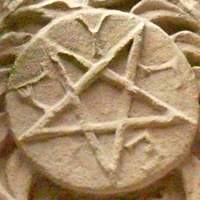 | |
16.This pentagram in the doorway keystone at 1 rue Jean-Gouthière, in Chaumont, France, is reminiscent of hermetic usage such as Robert Moray's ""mason's mark" (see above).
Also in Chaumont, the side door of the Saint John Basilica displays a pentagram-like carving, framed by two rotating stars or burning stars.
|
|